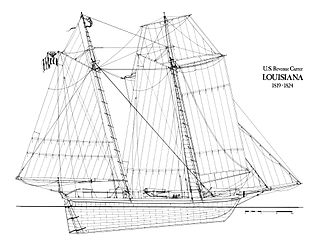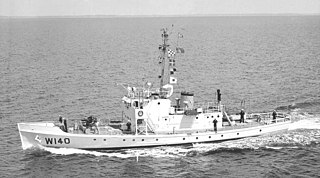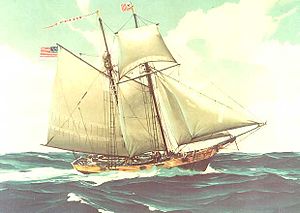Description
A contemporary description, provided by the Collector of Customs at Boston, Mr. Benjamin Lincoln to the Secretary of the Treasury, Alexander Hamilton, noted:
Agreeably to your orders I here send you a description of the Cutter Massachusetts built at Newbury port in the Commonwealth of Massachusetts in the year 1791. She has on [sic: one] deck, two masts her length is sixty feet above her upper deck her depth is seven feet Eight inches, breadth seventeen feet eight inches she measures seventy tons 43/95. She is a square-stern schooner, has quarter badges, an Indian's head for figurehead. She has a long quarter deck and a deep waist." [4] [5]
Dr. John Tilley noted that "the Massachusetts was a two-masted schooner of 70 43/95 tons burden, 60 ' in length, with a beam of 17' 8" and depth of hold of 7' 8". The ship had a long quarterdeck, deep bulwarks, and an armament of either four of six swivel guns. The contract signed by Searle and Tyler called for two boats and seven sails: mainsail, foresail, jib, flying jib, fore topsail, main topsail, and squaresail." [3] The cutter ended up being larger than originally authorized as her first master, John Foster Williams, ordered an increase in her size without first seeking departmental approval. Her cost was therefore considerably over the original estimate. Nevertheless, the government accepted her as built.
Operational service
Although she was launched later than a number of other cutters, by tradition she is considered to be the first to actually enter active service. [6]
There are a number of surviving documents regarding her history. A journal, kept by second mate Nathaniel Nichols, has turned up and gives a glimpse of what life was like on this cutter. He faithfully recorded his thoughts and actions from 31 October 1791 through 16 June 1793.
"No Revenue Cutter in Secretary of the Treasury Alexander Hamilton's 'system of cutters' saw shorter Federal service than the first [cutter named] Massachusetts, a 70-ton schooner built in Newburyport, Massachusetts in 1791. One of the first ten armed vessels of the United States ordered to patrol the Atlantic Coast to protect the revenue, she was too costly to please Alexander Hamilton, too expensive to operate to please General Benjamin Lincoln, and too slow to please her Master, Captain John Foster Williams. They sold her in October 1792 and replaced her the following spring with a smaller, livelier cutter, the sloop Massachusetts II." [7]

The United States Revenue Cutter Service was established by an act of Congress on 4 August 1790 as the Revenue-Marine upon the recommendation of Secretary of the Treasury Alexander Hamilton to serve as an armed customs enforcement service. As time passed, the service gradually gained missions either voluntarily or by legislation, including those of a military nature. It was generally referred to as the Revenue-Marine until 31 July 1894, when it was officially renamed the Revenue Cutter Service. The Revenue Cutter Service operated under the authority of the U.S. Department of the Treasury. On 28 January 28 1915, the service was merged by an act of Congress with the United States Life-Saving Service to form the United States Coast Guard.
John Foster Williams was an American mariner who served as an officer in the Massachusetts State Navy during the American Revolutionary War and later an officer in the Revenue-Marine.

United States Coast Guard Cutter is the term used by the U.S. Coast Guard for its commissioned vessels. They are 65 feet (19.8 m) or greater in length and have a permanently assigned crew with accommodations aboard. They carry the ship prefix USCGC.
USRC Walter Forward was a schooner constructed for service with the United States Revenue Marine. She was more commonly known as USRC Forward. Forward served with the U.S. Army and U.S. Navy in Mexican waters during the Mexican–American War and was commended for her actions during the Tabasco River landings by Commodore Matthew C. Perry, U.S. Navy. After the war, she was transferred to the U.S. Coast Survey for a short time as USCS Walter Forward before being returned to the Revenue Marine for service during the 1850s and the American Civil War.
One of the first ten revenue cutters, Active may have been the second of the ten cutters to enter service. The Columbian Centinel on 30 April 1791 noted:
A Revenue Cutter, was launched at Baltimore the 9th inst. at Captain Stodder's Ship Yard, and is considered by good judges, a beautiful vessel. She is to be commanded, we hear, by Capt. Gross, formerly First-Lieutenant of the Continental Frigate CONFEDERACY.
USRC General Green was one of the first ten cutters operated by the U.S. Revenue Cutter Service. She was named for the Revolutionary War hero Major General Nathanael Greene. Her name was misspelled, probably by the man who oversaw her construction, the Collector of Customs in Philadelphia, Sharp Delany. Apparently the cutter was to have been originally named for the Secretary of the Treasury, Alexander Hamilton, but Delany changed the name for reasons unknown.
USRC Scammel was one of the first ten cutters operated by the United States' Revenue Cutter Service.
USRC Argus was one of the first ten cutters operated by the United States' Revenue Cutter Service. Of the ten cutters, she was the longest to serve in this role.
USRC Diligence was one of the first ten cutters operated by the United States' Revenue Cutter Service.
USRC South Carolina was one of the first ten cutters operated by the United States' Revenue Cutter Service.
USRC Eagle was one of the first ten cutters operated by the United States Revenue-Marine, which later became the United States Revenue Cutter Service and later still became part of the United States Coast Guard.

USRC Mohawk, was a steel steam powered revenue cutter built for the U.S. Revenue Cutter Service by William R. Trigg Company at Richmond, Virginia. Her primary duties in the Revenue Cutter Service and Coast Guard were assisting vessels in distress and enforcing navigational laws as well as a derelict destroyer. Mohawk was sunk after a collision with another vessel in October 1917.
USRC Forward was a revenue cutter constructed for the U.S. Revenue Cutter Service in 1882 by Pusey & Jones shipyard in Wilmington, Delaware. She was the second Revenue Cutter Service vessel named Forward and was named for Walter Forward, the fifteenth United States Secretary of the Treasury. The iron-hulled vessel originally cost US$72,750 and was powered by a two-cylinder steam engine with a topsail schooner brigantine sail pattern. Although Forward was considered a model ship at the time of its construction, it was severely underpowered and had unreliable machinery. The cost of repairs in the first fifteen years of operation was US$52,000.
The capture of the schooner Bravo was a naval battle fought in 1819 between United States Revenue Cutter Service cutters and one of Jean Lafitte's pirate ships.
USRC Alabama, was a wood-hull topsail schooner designed by William Doughty that was commissioned in the United States Revenue Marine from 1819 to 1833. Assigned the homeport of Mobile, Alabama, she sailed the Caribbean extensively with her sister ship, USRC Louisiana and was used mainly in anti-piracy activity.

USRC Louisiana, was a wood hull topsail schooner designed by William Doughty that was commissioned in the United States Revenue Marine from 1819 to 1824. Assigned the homeport of New Orleans, Louisiana, she sailed the Caribbean extensively and was used mainly in anti-piracy activity.

USCGC General Greene (WPC/WSC/WMEC-140), was a 125 ft (38 m) United States Coast Guard Active-class patrol boat, in commission from 1927 to 1968 and the fourth cutter to bear the name of the famous Revolutionary War general, Nathanael Greene. She served during the Rum Patrol, World War II and into the 1960s performing defense, law enforcement, ice patrol, and search and rescue missions.

USRCSurveyor was a ship of the United States Revenue Marine captured by the United Kingdom during the War of 1812. Despite the vessel's loss, the "gallant and desperate" defense of her crew against a superior force of the Royal Navy and the Corps of Royal Marines is commemorated by the United States Coast Guard. Along with the Royal Navy frigate which bested her in battle, HMS Narcissus, Surveyor is among six legendary ships memorialized in the lyrics of the Coast Guard march "Semper Paratus".
USRC Harrison was the lead ship of her topsail schooner class, which was built and operated by the United States Revenue-Marine, later Revenue Cutter Service, between 1849 and 1856.
USRC Ingham was the second ship of the Harrison schooner class, which was built and operated by the United States Revenue Cutter Service between 1849 and 1856. She is the third ship of the Revenue Cutter Service to bear the name.






